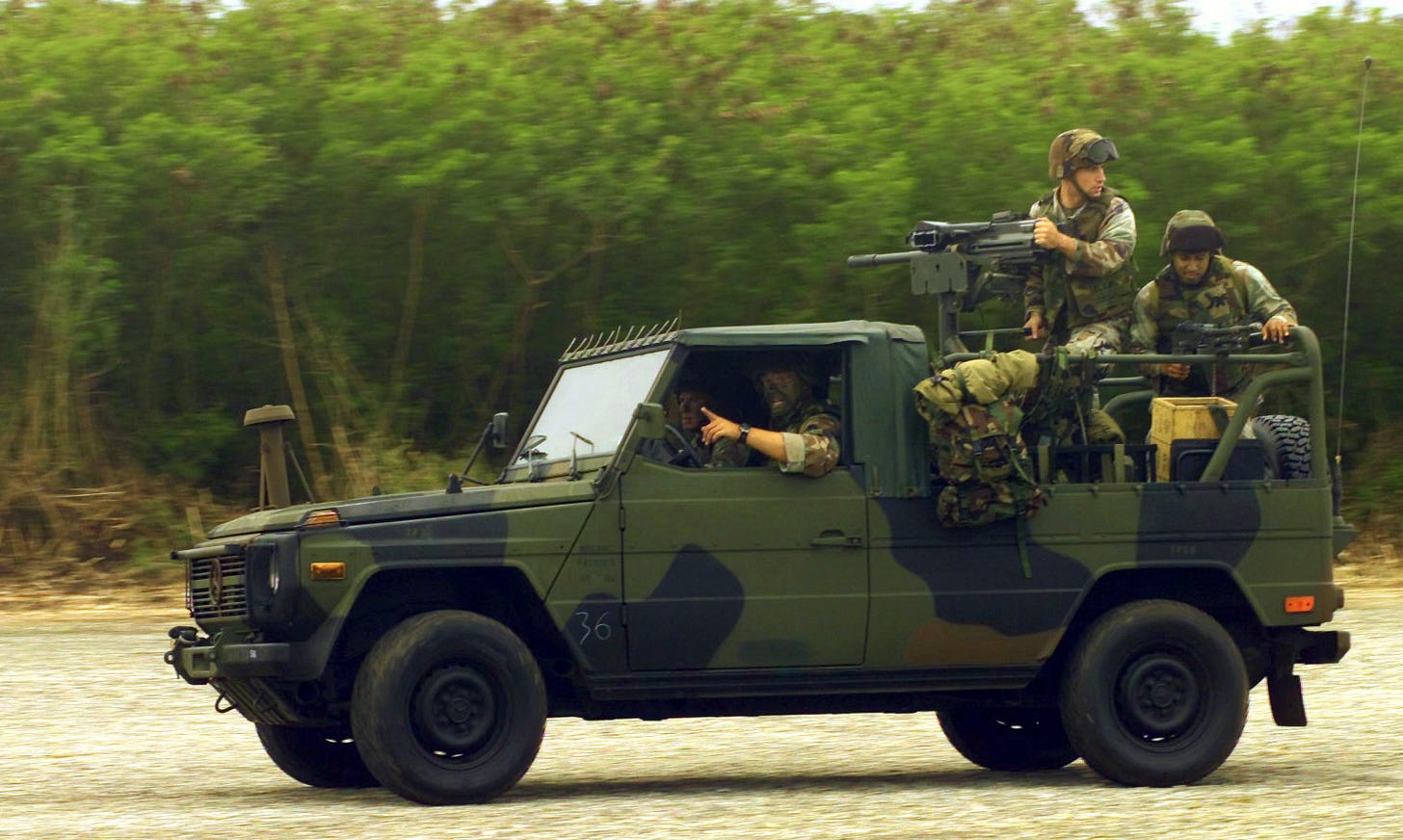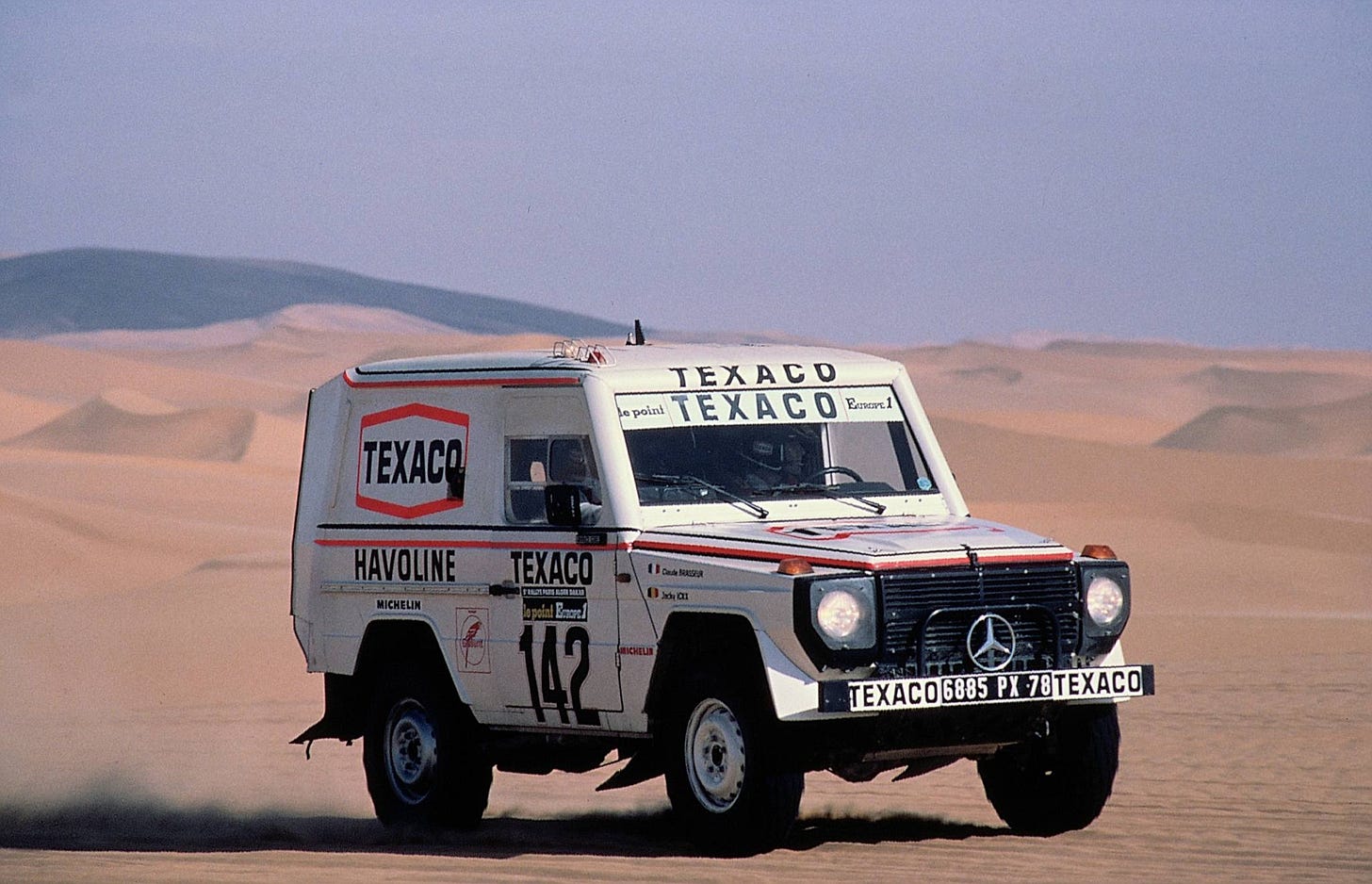Cool Whip
I’m not there yet, but I gather that 45 is a good age. You’ve made peace with your greys; accepted that becoming a film star or a world class athlete is not going to happen. You’re kinder on yourself, and your paunch. You eat better, and demand less from your body and mind.
Imagine, if you will, a different sort of 45-year-old. He’s all waxed chest and gelled hair; lounging about in one of those fitted, open-collared shirts and sleek black trousers. You notice the incredible skin. The perfectly manicured nails. But no amount of idle-rich cosplaying and laidback demeanour can hide the obvious: he’s ex-military. It’s in his posture. In his deep voice and clipped words. This is a man who’s seen some shit. And who you can depend on to get you safely through an apocalypse.
This is the Mercedes Benz G63 AMG. It is the universal symbol of having arrived, anywhere in the world. Its allure and charm transcends borders. It is the top of the food chain- the apex predator of the 5-star hotel porch. Here’s Throttle House demonstrating the G-Wagen wave:
And yet, this car had very different origins:
How’d we get from this to that? Here’s the incredible story of my all-time favourite car- the Mercedes Geländewagen.
We start in the mid-70’s. Mercedes was already a storied name. Worldwide, it stood for engineering excellence, luxury and glamour. After all, the bar is high for getting namedropped in iconic songs:
Her mind is Tiffany-twisted, she got the Mercedes-Benz, uh
She got a lot of pretty, pretty boys that she calls friendsHotel California by The Eagles, 1976.
The 70’s was an interesting time even outside the American rock scene. The Cold War had forced most of the world to take sides, covertly or overtly. The Oil Crisis happened in 1973, and America was forced to confront its utter dependance on imported crude from the Middle East. Its own oil industry was in seemingly terminal decline. Even among OPEC one figure loomed large:
“The leader who pushed the most for higher oil prices was the Shah of Iran, and the Italian historian Giuliano Garavini has argued that the leader most responsible for the West's economic problems during the "oil shock" was not King Faisal, but rather the Shah.”
The price of crude went from $3 to $12 per barrel, with no significant increase in extraction costs. This was the first time the oil producing countries had flexed their muscle. But The Shah of Iran, thrower of epic parties that have their own Wikipedia page, was already at work behind the scenes. He had picked up large stakes in many (then) West German corporations, as this New York Times article from 1975 reports in a slightly alarmed tone.
The Shah had always been an avid car collector, stoked in part perhaps by the stunning wedding gift he got from the French government back in 1939:

It tracked, then, that he also picked up a big stake in Daimler-Benz, the parent company of Mercedes. Being a large shareholder comes with its privileges, like a literal seat at the table. The Shah, in his wisdom, asked Mercedes to develop a rugged new vehicle for the Iranian armed forces. His 20000-unit initial order probably helped the suggestion go down easily. Mercedes roped in Steyr-Daimler-Puch, an Austrian contract manufacturer, to co-develop and build the new model.
Development began in 1972, with the first wooden model ready in 1973. Clay is normally used for models, but the flat lines of the car meant wood worked just as well. By 1974, prototypes were being rigorously tested in conditions as varied as the Sahara Desert, the Arctic Circle and various German coalfields. A new plant was built, and production finally began in 1979 in the Graz facility in Austria. Unfortunately, this was too late for the Shah. He had been deposed by then, and Iran never took delivery of the 20000 cars.
Mercedes also announced a civilian version. The proposition was simple – this was a hardy, workman’s tool. Available in a variety of engines and body styles, it was intended to be adaptable to a variety of heavy-duty use cases, both civilian and military. The spartan interior and utter lack of comfort features was a testament to this – the fewer things you had, the lesser the chances of them breaking down in the field. So no AC, and no automatic transmission. Too fancy.
The world at large first saw the G when it made an appearance in 1980 as the official Popemobile, probably chosen for its sturdy platform and flexible-yet-reliable ladder-on-frame construction.
A weird sidebar- Steyr-Daimler-Puch actually had the marketing rights to the car in Austria, Switzerland, Yugoslavia (and its successor states: Bosnia-Herzegovina, Croatia, Macedonia, Serbia, and Slovenia), Mongolia, and Eastern European COMECON countries. Here, it was badged and sold as the Puch G until 2000, when the agreement expired.
Weirder still, the Popemobile was rebadged with Puch emblems for Pope John Paul II’s 1983 Austria visit. Even the Holy Father doesn’t mess with copyright agreements.
Another notable example had an interesting history.
The Falklands War was a ten-week undeclared war between Argentina and the United Kingdom in 1982 over two British dependent territories in the South Atlantic: the Falkland Islands and its territorial dependency, South Georgia and the South Sandwich Islands.
During the brief war, commanders of the 18 Squadron of the Royal Air Force (RAF) were given use of a captured Argentine G-Wagen. A 1981 example, the G had taken cannon fire from a Harrier jet, and had holes in its bonnet and inner fender to prove it. Still, it was serviceable and performed honourably. The 18 Squadron took the G back with them to West Germany after hostilities ceased, where it was used extensively. It may even have taken a trip to the Middle East during the 1990 Gulf War.
Here’s my favourite bit of the story - in 1993, after 10 years of hard service, the G started to show its age. A routine request went in to the Mercedes dealer for a spare part. The request form mentioned the chassis number. This raised a flag at Mercedes. Argentina had never paid for the consignment! Mercedes demanded return of their stolen property. RAF personnel pointed out that the G was a spoil of war, and the universal maxim of finders keepers thus applies.
The G was retired in 2001 and is displayed at the RAF museum.
But back to our story.
In 1983, Jacky Ickx and Claude Brasseur won the gruelling Paris-Dakar rally, a 10000 km race including sections crossing the Sahara. They were driving a 280GE.
Safe to say, the G’s reputation was well earned. But it was still a purpose-built tool. Civilian use in Europe remained limited to utilitarian functions. For this reason, Mercedes never sold the G in the US, where it had established itself as a luxury car brand. Besides, current G models were underpowered and spartan, the antithesis of what the American car buyer wanted.
Slowly though, a grey market developed in the 80’s. A small but informed set of buyers in the US were lapping up G’s that were imported without Mercedes’ knowledge or consent. Chief and most professional among the importers was Europa International. A 1988 legislation put that to an end though: H.R.2628 – the Imported Vehicle Safety Compliance Act of 1988 repealed the authority of the Secretary of Transportation (the Secretary) and the Secretary of the Treasury to permit the temporary importation of vehicles that do not conform to Federal safety standards.
All imports would now have to meet US safety and emission standards. Fun fact – it’s probably the same act that has Tom Cruise’s Lamborghini shipment stuck at customs in Rain Man (1988).
It was a company defining moment for Europa. They decided to go all in. After signing an exclusivity contract with Mercedes for North America, Europa underwent the five-year US certification program and finally got the OK to start selling the G officially in the US. In this interim, Mercedes had debuted the second generation of the G in 1990. It was more luxurious, more powerful, less utilitarian and more desirable.
No doubt, the latent US demand had taken them by surprise. This was the largest car market in the world, and it was a no-risk move for Mercedes. They still offered a stripped down, barebones variant in the rest of the world for Professionals. Armed Forces, Government and NGO orders were in full swing. If Europa was willing to go through the pain and expense of demonstrating the potential of the US market, Mercedes had no issues offering more powerful and plush (read “Americanized”) variants.
Europa knocked it out of the park. The vehicle was luxurious, desirable and rare in the US. Technicians were trained in Germany, and service was impeccable. All deliveries were made at customer doorsteps, and the cars were covered in transit. The unattainability made the G even more desirable. Their ads positioned it perfectly:
Europa received small manufacturer status in the US in 1998, which meant it could finally import US-specced cars directly from Graz, no retro fitment necessary for safety or emissions. Europa now sold 10% of global G500 volumes. Incredible! Obviously, Mercedes terminated the agreement in 2002, and repurchased the distribution rights from Europa. They had seen enough to know what a cash cow the G was going to be.
The first AMG version came out around this time. AMG had started as a madcap modifier of Mercedes cars (with official approval and warranties), until Daimler bought them out in 1999. The AMG variant usually meant that the engine was tuned for a higher output, more noise and a more visceral experience. This variant moved the exhaust tips under the rear doors, both to shorten their length and place them closer to the occupants. End result: a much louder car, but one which was worse off road. Oh, and it did 0-100 kmph in about 7 seconds, less than many performance cars of the time. While being shaped like a brick.
This was when the G finally crossed the Rubicon. It had shed all pretence of being a workhorse. It was finally a luxury good, flashed in rap videos and recognised by silhouette alone. It represented desire. And sex. And money. In taking a utility tool and turning everything up to eleven, Mercedes followed the same path as Rolex. The watch brand, too, had once been known as a buy-it-for-life workman's tool. It, too, now stood for aspiration and signalling wealth.
The G has undergone two more model changes since, one minor and one major. The latest version is sold out in India until October next year. There is even a fully electric version now, which brings the same no-fucks-to-give vibe with its signature “G-turn”:
I haven’t even touched upon the absolutely mental special editions that Mercedes has done over the years, including a six wheeled 6x6 variant:
And a bonkers lifted 4x4² with 37-inch tires. You read that right- the tires are over three feet tall. From the factory. Madness.

Through the years, Mercedes has retained the iconic silhouette while abiding by new emission and pedestrian safety norms. The ridiculous front indicators remain, even if it takes €5m in R&D costs to make them acceptable for crash regulations. The doors still need an agrarian shove to close, and the door locks still sound like a bolt action rifle. That’s what lends the G its cool aura. Knowing, without ever needing to actually find out, that your car is capable of almost anything, if you so choose. That’s the key to its success, that excess in everything.
I like to think that our 45-year-old military man has settled nicely in civilian life. Done a bit of modelling, maybe even some walk on parts in a film or two. He hangs out with rappers, and knows all the cool nightclubs. And if things ever go south, you can always count on him to bail you out.
Hey there! If you’re new here, Internet Stuff is a newsletter about interesting stuff from the internet (and the occasional personal essay). Consider subscribing, if you like what you see.
Programming note: I know, I’ve been MIA for a week. I’ve taken a breather (and there’s a great story there that I’ll probably tell one day). But I’ve also been thinking- it may be time for this newsletter to evolve into its second iteration. Maybe. Expect longer pieces like today’s, and possibly a lower frequency. I’m still undecided, but promise to keep you posted. Thanks!











Whew, what a ride! :D
A big 👍🏽 for more longer pieces. Love the way you unpack the story behind a product.